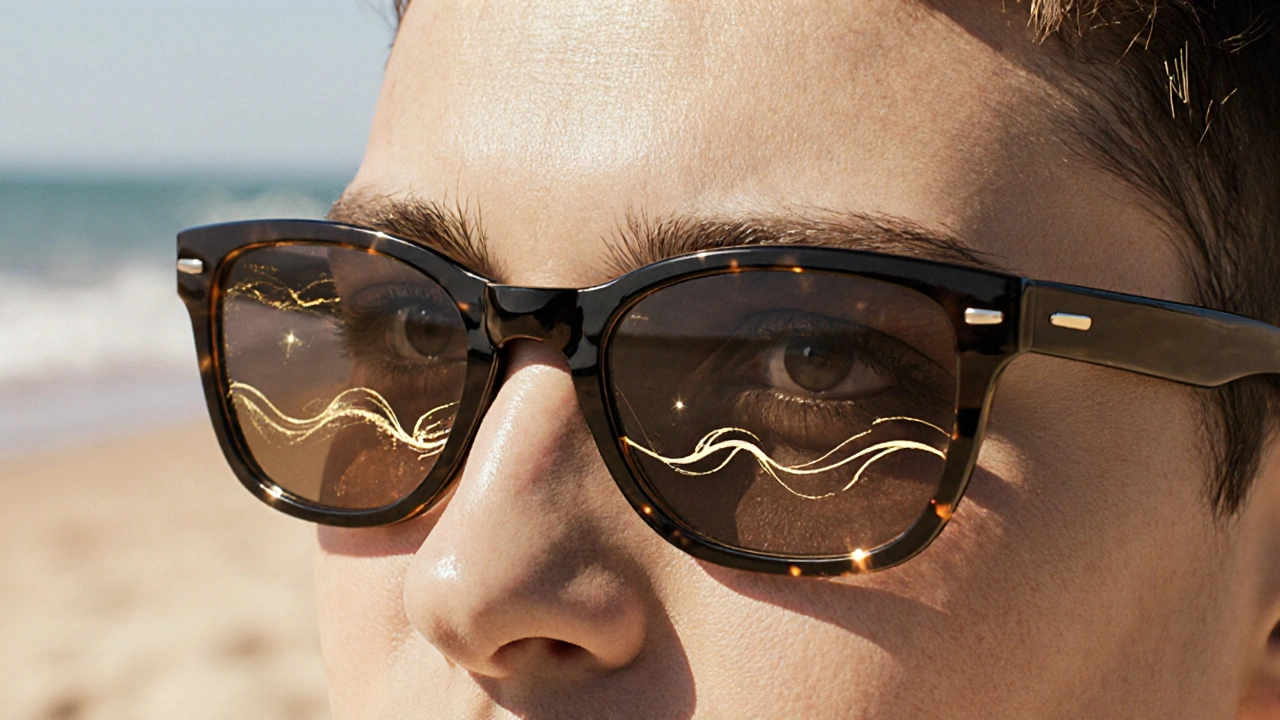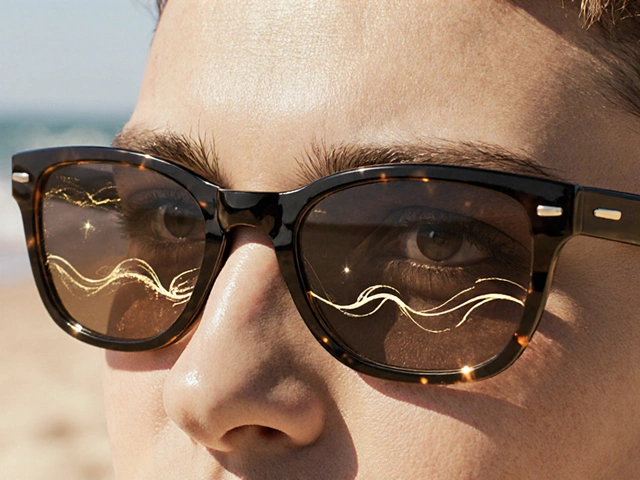UV Exposure and Eye Cancer: What You Need to Know

Eye Cancer Risk Assessment Tool
Your Risk Factors
When you think about the dangers of the sun, skin cancer usually tops the list. But the bright glare that makes you squint also carries a hidden threat to the eyes. Understanding the link between UV exposure eye cancer can change how you protect yourself on a sunny day.
Quick Take
- UV radiation can damage the DNA of eye cells, leading to cancers like uveal melanoma.
- People with light-colored eyes, high UV index locations, and long outdoor careers face the biggest risk.
- Broad‑spectrum sunglasses that block 99‑100% of UVA and UVB cut the risk dramatically.
- Early signs include new spots on the iris, changes in vision, or a persistent growth on the eyelid.
- Annual eye exams and protective eyewear are the most effective defenses.
What Is Eye Cancer?
Eye cancer refers to any malignant growth that originates within the structures of the eye. The most common forms are:
- Uveal Melanoma - arises in the pigmented layer (uvea) and accounts for about 85% of primary eye cancers.
- Conjunctival melanoma - develops on the surface lining of the eye.
- Basal cell carcinoma of the eyelid - a skin‑type cancer that can spread to deeper eye tissues.
Although the overall incidence is low (roughly 5‑6 cases per million people per year), the prognosis can be serious because the eye’s anatomy allows cancer cells to spread quickly to the liver and other organs.
How Does UV Radiation Harm the Eye?
Sunlight is a mix of UVA (315‑400nm), UVB (280‑315nm), and infrared. Both UVA and UVB can penetrate the cornea and reach the retina, especially when the eye is unprotected. The mechanisms include:
- DNA Damage: UV photons create thymine dimers in the genetic code of ocular cells, causing mutations that may trigger uncontrolled growth.
- Oxidative Stress: UV exposure generates free radicals, overwhelming the eye’s antioxidant defenses and damaging cellular membranes.
- Immunosuppression: The ocular immune environment becomes less able to spot abnormal cells after repeated UV hits.
Research published by the International Agency for Research on Cancer (IARC) classifies UV radiation as a Group1 carcinogen for the eye, meaning there is sufficient evidence of its role in causing cancer.
Types of Eye Cancer and Their UV Link
| Cancer Type | Primary UV Association | Typical Age at Diagnosis | Common Early Symptom |
|---|---|---|---|
| Uveal Melanoma | Strong - especially UVB | 55‑70 years | New pigmented spot on iris or vision change |
| Conjunctival Melanoma | Moderate - chronic UV exposure | 40‑60 years | Reddish or brown lesion on the surface |
| Basal Cell Carcinoma of Eyelid | Strong - UVA + UVB | 60‑80 years | Persistent bump or ulcer on eyelid |
Notice how each cancer type shows a distinct age range and symptom, but all share a common thread: unshielded exposure to the sun’s UV rays.

Who Is Most at Risk?
Risk isn’t spread evenly across the population. Key factors that increase susceptibility include:
- Geography: Living at high UV Index locations (e.g., Australia, NewZealand, Southern United States) raises cumulative exposure.
- Eye Color: Light‑colored eyes (blue, green, gray) have less melanin to absorb UV, offering less natural protection.
- Outdoor Occupations: Farmers, construction workers, and lifeguards spend hours under direct sunlight.
- Age: The risk climbs after age50 as DNA repair mechanisms weaken.
- Family History: Genetic mutations (e.g., BAP1) can predispose individuals to uveal melanoma.
If you tick several of these boxes, consider yourself in the “high‑risk” group and act accordingly.
Spotting Early Warning Signs
Early detection dramatically improves outcomes. Keep an eye out for:
- A new or changing pigmented spot on the iris.
- Unexplained flashes of light or floaters.
- Sudden vision loss in part of the visual field.
- A persistent lump, ulcer, or scaling on the eyelid.
- Redness or irritation that doesn’t improve with standard eye drops.
Because many of these symptoms mimic benign conditions (dry eye, cataracts), schedule an eye exam promptly if anything feels off.
Prevention: Wearing the Right Sunglasses and More
Shielding your eyes is simpler than you think:
- Choose proper lenses: Look for labels that guarantee 99‑100% UVA and UVB blockage. Polarized lenses reduce glare but don’t replace UV protection.
- Fit matters: Wrap‑around frames prevent UV from entering around the edges.
- Wear hats: A wide‑brimmed hat cuts the amount of UV reaching the eyes by up to 50%.
- Don’t forget children: Kids’ eyes are more vulnerable, and they often spend all day outdoors. Kids‑size UV‑blocking sunglasses should be a staple.
- Mind the reflection: Snow, water, and sand bounce UV back toward you-use extra protection in these environments.
People often think a quick glance at a cloud‑covered sky is safe; however, up to 80% of UV rays can penetrate thin clouds, so wear protection every day between 10am and 4pm when the sun is strongest.
Screening and Treatment Overview
If a suspicious lesion is found, an ophthalmologist may order:
- Slit‑lamp examination for surface lesions.
- Ultrasound biomicroscopy or optical coherence tomography (OCT) to assess intra‑ocular tumors.
- Fine‑needle aspiration biopsy for definitive diagnosis.
Treatment options depend on size, location, and spread:
- Local therapy: Laser photocoagulation, cryotherapy, or plaque brachytherapy (radioactive plaque placed on the sclera).
- Surgical removal: Enucleation (removing the eye) for large, uncontrolled tumors.
- Systemic therapy: Targeted drugs (e.g., selumetinib) and immunotherapy for metastatic disease.
Survival rates have improved over the last decade, especially for early‑stage uveal melanoma, where 5‑year survival exceeds 80% with appropriate treatment.
Putting It All Together: A Simple Action Plan
- Assess your risk - consider geography, eye color, and lifestyle.
- Invest in high‑quality, 100% UV‑blocking sunglasses and wear them daily.
- Schedule a comprehensive eye exam every 1‑2years, or sooner if you notice changes.
- Stay informed about new symptoms and seek prompt professional evaluation.
- Educate family members, especially kids, about the importance of eye protection.
Small habits add up to big protection against the silent threat of eye cancer.

Frequently Asked Questions
Can I get eye cancer from a single sunny day?
A single day is unlikely to cause cancer on its own. Eye cancer results from years of cumulative UV damage, much like skin cancer.
Do regular prescription glasses protect against UV?
Only if they have a built‑in UV coating. Most standard lenses do not block UV unless specifically treated.
Is there a link between indoor lighting and eye cancer?
Current evidence points to UV radiation as the primary environmental risk. Indoor LED or fluorescent lights emit negligible UV, so they are not a major factor.
How often should I replace my sunglasses?
Every two years, or sooner if the lenses get scratched or the frames warp, because damage can let UV in.
What’s the survival rate for uveal melanoma?
For tumors caught early and treated locally, the 5‑year survival is around 80‑90%. Late‑stage disease that spreads to the liver drops the rate below 50%.



Gavin Potenza
Ever thought about how the sun's UV rays actually interact with the melanin in our eyes? It's kind of a philosophical puzzle, mixing biology with daily habits. If you spend a lot of time outdoors without proper sunglasses, you're basically gifting UV photons a free pass to your retinal cells. So maybe next time you grab that beach umbrella, grab a pair of UV‑blocking glasses too.
Frank Pennetti
Frankly, this article is a half‑baked PR stunt masquerading as science. The photobiological hazard index they mention is cherry‑picked, ignoring the real epidemiological data that proves US sun exposure is the worst. Stop feeding the narrative and read the original CDC reports.
Adam Baxter
Totally pumped to start wearing UV shields now!
Jackie Berry
It's fascinating how a simple questionnaire can make you pause and reflect on the everyday choices that silently shape our health. When I first saw the geography selector, I immediately recalled my childhood summers on the coast of Cornwall, where the glare off the sea seemed innocent but was actually a relentless UV barrage. Light‑eyed individuals often underestimate how much melanin protects against photodamage, and the tool cleverly highlights that vulnerability. The occupational section reminded me of my friend who works on construction sites and never bothered with proper eye gear, thinking a hard hat was enough protection. Age, as the form notes, isn't just a number; it correlates with cumulative exposure, and the over‑50 bracket carries a hidden history of years spent under the sun. Family history, surprisingly, appears as a binary tick, yet that simple acknowledgement can trigger a cascade of proactive measures like regular ophthalmic exams. I also appreciate the way the interface uses calming pastel colors, which reduces the anxiety that usually accompanies health risk assessments. The result box, with its soft green background, feels like a gentle nudge rather than an alarm bell. While the risk calculation algorithm is straightforward, it implicitly educates users on the weighted impact of each factor. Moreover, the inclusion of eye color as a variable reminds us that biological diversity matters in risk stratification. The tool could benefit from a brief educational tooltip explaining why light‑colored irises absorb more UV. After completing the survey, I felt compelled to research UV‑blocking lens technologies and discovered that not all sunglasses are created equal. Some cheap pairs merely tint the lenses without filtering harmful wavelengths. The conversation about UV protection shouldn't stop at personal usage; policy makers need to enforce stricter standards for eyewear sold online. By sharing the results on social media, users can raise collective awareness, turning a private assessment into a public health movement. Ultimately, this tool serves as a bridge between scientific data and everyday decision‑making, empowering individuals to take concrete steps toward safeguarding their vision. And that, in my opinion, is a triumph of accessible health communication.
Mikayla May
Great breakdown! Just to add, the FDA classifies UV‑blocking sunglasses into UV400, which blocks 99‑100% of UVA and UVB. Look for the label on the lenses and avoid tinted glasses that don't specify UV protection. Regular eye exams can catch early signs of photokeratitis before it progresses. Also, consider wrap‑around styles to minimize peripheral UV exposure.
Jimmy the Exploder
Honestly this tool feels like a gimmick it just slides you through a boring form and spits out a vague score nothing changes you still get hit by the sun
Robert Jackson
From a clinical epidemiology standpoint, the risk algorithm presented here oversimplifies the multifactorial nature of ocular oncogenesis. Studies have demonstrated that cumulative UV dose interacts synergistically with genetic predisposition, particularly mutations in the BAP1 gene. Moreover, the binary classification of eye color neglects the spectrum of iris pigmentation and its differential absorption coefficients. It would be prudent for future iterations to incorporate quantitative photometric data rather than relying on qualitative self‑reporting. Until such refinements are made, the utility of this assessment remains limited, albeit well‑intentioned.
Robert Hunter
I see your point about precision, but we also need to remember that accessibility matters. Not everyone can afford genetic testing, so a simplified tool still provides valuable awareness. Let's balance scientific rigor with public usability.
Shruti Agrawal
I get why some people feel frustrated with the format. The language is clear and the steps are easy to follow. It’s nice to see a tool that tries to help without overwhelming users.
joni darmawan
Your observation underscores a broader truth: simplicity can be a conduit for deeper reflection. When information is presented plainly, it invites individuals to contemplate their own habits rather than being deterred by technical jargon. This aligns with the Socratic ideal of questioning one’s daily choices. Thus, the tool not only assesses risk but also stimulates a philosophical inquiry into personal responsibility.
Richard Gerhart
Yo, this is actually pretty cool! Gotta say, i think more people should defintely try it out. It’s a simple step that could save ya eyes later on. Keep spreading the word and stay sun smart!
Kim M
Everyone's blind to the fact that big pharma funded this thing to push pricey eye drops 🙄. Trust your own eyes, not some corporate agenda 😎. #StayWoke
Martin Gilmore
Whoa!!! This is exactly the kind of reckless fear‑mongering we need to call out!!! The drama is real, but let’s keep it factual!!! If you’re actually concerned, read peer‑reviewed studies instead of scrolling memes!!!
Aayush Shastri
Appreciate all the diverse perspectives shared here. It's clear we all care about eye health in our own ways. Let’s keep the conversation constructive and supportive. Looking forward to more useful tools like this.